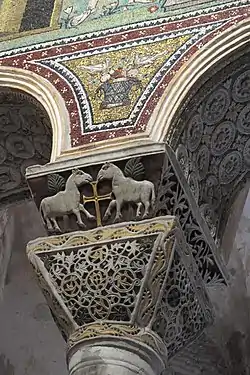Pulvino
A pulvino (or impost block) is an architectural structural element (dosseret) having the shape of an inverted pyramid cushion, which is placed between the column capital and the arch base.[1][2][3]

Overview
Usually decorated with fretwork or relief ornamental motifs, the pulvino reaches its maximum expression in the Byzantine architecture;[4] some examples can be found in the early Christian architecture of Ravenna.[5] Its particular convex shape gives the pulvino the structural function of concentrating the tensions generated by the loads above it and passing the tensions on the column located below the capital. An example can be seen in the church of San Lorenzo in Florence designed by Filippo Brunelleschi around 1420. There he resorted to additional segments of entablature improperly defined as "Brunelleschian nut". The pulvino in this case created a balanced entablature, on which the round arches are set.
Modern engineering
In contemporary engineering, the pulvino is used as a structural element to distribute the load between an overlying part with less mechanical resistance and an underlying part with higher resistance. For example, it is used in railways to transfer the load of rails onto sleepers. Generally, it is made of cast iron.
Gallery
_12.jpg.webp)
_04.jpg.webp)


 Pulvino over a capital
Pulvino over a capital
References
- "Pulvino | Definition of Pulvino by Oxford Dictionary on Lexico.com also meaning of Pulvino". Lexico Dictionaries | English. Retrieved 4 August 2020.
- Spence-Jones, Henry Donald Maurice (1914). The secrets of a great cathedral. J.M. Dent. p. 5. Retrieved 4 August 2020.
- Jackson, Sir Thomas Graham (1925). Architecture. Macmillan. p. 31. Retrieved 4 August 2020.
- Byzantine and Romanesque Architecture. CUP Archive. p. 52. Retrieved 4 August 2020.
- Jackson, Sir Thomas Graham (1906). Reason in Architecture: Lectures Delivered at the Royal Academy of Arts in the Year 1906. J. Murray. p. 30. Retrieved 4 August 2020.